| Country | indicator_name | 2020 | 2019 | 2018 | 2017 |
|---|---|---|---|---|---|
| Denmark | Corruption (0=high; 100=low) | 87 | 88 | 88 | 90 |
| New Zealand | Corruption (0=high; 100=low) | 87 | 87 | 89 | 90 |
| Finland | Corruption (0=high; 100=low) | 86 | 85 | 85 | 89 |
| Singapore | Corruption (0=high; 100=low) | 85 | 85 | 84 | 84 |
| Sweden | Corruption (0=high; 100=low) | 85 | 85 | 84 | 88 |
| Switzerland | Corruption (0=high; 100=low) | 85 | 85 | 85 | 86 |
| Norway | Corruption (0=high; 100=low) | 84 | 84 | 85 | 85 |
| Netherlands | Corruption (0=high; 100=low) | 82 | 82 | 82 | 83 |
| Germany | Corruption (0=high; 100=low) | 80 | 80 | 81 | 81 |
| Luxembourg | Corruption (0=high; 100=low) | 80 | 81 | 82 | 81 |
12 Terrorism and Insurgencies: Tracking Non-State Actors with Data Science
Terrorism and insurgencies, driven by non-state actors, pose significant challenges to global security and international stability. As these movements operate across borders, leverage decentralized networks, and adapt to changing geopolitical landscapes, traditional methods of counterterrorism and intelligence are often insufficient. In this context, data science has emerged as a critical tool for tracking, analyzing, and understanding the activities of terrorist organizations and insurgent groups. By using geospatial data, network analysis, and social media scraping, data scientists and security agencies can gain insights into terrorist recruitment patterns, operational tactics, and the global impact of these non-state actors on security.
This chapter explores how data science techniques are applied to study and combat terrorism and insurgencies. From mapping the geographic distribution of terrorist incidents to analyzing the social networks of recruitment and propaganda dissemination, this chapter will examine the key methods used to track terrorist activities. We will also explore how machine learning and predictive modeling can forecast future threats and help policymakers develop more targeted counterterrorism strategies. By integrating data from diverse sources, such as social media, financial transactions, and conflict databases, researchers can provide a more comprehensive understanding of non-state actors’ influence on global security.
12.1 Geospatial Data: Mapping Terrorist Incidents and Insurgent Movements
One of the most effective tools in counterterrorism efforts is geospatial analysis, which allows researchers and security agencies to map the geographic distribution of terrorist activities and insurgent movements. Using datasets like the Global Terrorism Database (GTD) and the Armed Conflict Location & Event Data Project (ACLED), analysts can visualize where terrorist attacks are occurring, identify hotspots of insurgent activity, and track the evolution of conflicts over time (Raleigh et al., 2010). Geospatial analysis helps answer critical questions about the geography of terrorism: Where are attacks concentrated? What regions are most vulnerable? How do terrorist groups exploit geographic features such as borders, remote areas, or urban environments?
For instance, ISIS leveraged its control of vast territories in Syria and Iraq between 2014 and 2017 to establish a de facto state, using oil revenues and territorial gains to fund its operations (Clarke, 2018). By mapping ISIS’s territorial gains and losses, analysts could monitor the group’s reach and predict areas at risk of attack. Similarly, geospatial data has been used to track the movements of Al-Shabaab in Somalia and Kenya, providing insights into how the group exploits regional instability to carry out attacks across borders (Botha, 2014).
Heatmaps of terrorist activity provide visual representations of attack frequency, revealing patterns that can inform resource allocation for counterterrorism efforts. For example, the Sahel region of Africa has become a hotspot for terrorist activity, with groups like Boko Haram, Al-Qaeda in the Islamic Maghreb (AQIM), and the Islamic State in the Greater Sahara (ISGS) exploiting weak governance and porous borders to launch attacks. Geospatial models can be used to predict where future attacks are likely to occur based on historical data, demographic factors, and socio-political conditions (Tollefsen & Buhaug, 2015).
12.2 Network Analysis: Understanding Recruitment and Operational Networks
Terrorist and insurgent groups often operate within complex, decentralized networks, relying on informal connections between cells, individuals, and sympathizers. Network analysis allows researchers to map these relationships, uncovering the underlying structures of terrorist organizations and how they evolve over time. By analyzing the social, financial, and logistical networks that sustain terrorist groups, security agencies can disrupt their operations more effectively.
Social network analysis (SNA) is particularly useful in understanding how terrorist organizations recruit members, coordinate attacks, and disseminate propaganda. For example, in the case of ISIS, the group’s sophisticated use of social media allowed it to recruit thousands of foreign fighters from around the world, creating a global network of sympathizers and operatives (Berger & Morgan, 2015). By mapping the online networks of ISIS recruiters and identifying key influencers, data scientists were able to disrupt recruitment pipelines and target propaganda efforts.
Financial networks are another critical area where network analysis proves valuable. Terrorist groups often rely on complex financial transactions, including money laundering, smuggling, and charitable donations, to fund their activities. Network analysis of financial transactions helps identify the nodes—such as key financiers or intermediaries—within these networks that are crucial to sustaining terrorist operations. For example, Hawala networks—an informal system of money transfer prevalent in the Middle East and South Asia—are often used by terrorist groups to move funds across borders without detection by formal banking institutions (Passas, 2003). By mapping these networks, security agencies can target the individuals and organizations facilitating the flow of money to terrorist groups.
Network analysis is also crucial in understanding the operational structures of insurgent groups. In insurgencies such as the Taliban in Afghanistan or FARC in Colombia, networks of local operatives, tribal leaders, and external supporters sustain operations across large and often difficult-to-govern regions. By analyzing the relationships between insurgent leaders, local power brokers, and international backers, analysts can identify weaknesses in these networks and develop strategies to isolate key actors.
12.4 Predictive Modeling: Forecasting Terrorist Activity and Insurgencies
One of the most powerful applications of data science in the fight against terrorism and insurgencies is predictive modeling. By using machine learning algorithms to analyze past terrorist incidents, researchers can develop models that forecast future attacks, identify vulnerable regions, and predict the likelihood of insurgencies emerging in specific areas. These models are often built on a combination of factors, including historical attack data, socio-economic conditions, political instability, and geographic features.
For example, machine learning models have been used to predict the likelihood of insurgent attacks in Afghanistan based on factors such as local governance structures, the presence of foreign troops, and the proximity to Taliban-controlled areas (Berman et al., 2011). These models allow military planners and policymakers to allocate resources more effectively, targeting areas where the risk of insurgent activity is highest.
Similarly, predictive models can forecast terrorist recruitment trends, using data on demographics, social media activity, and political grievances to identify individuals or regions at risk of radicalization. By identifying these trends early, governments can implement preventative measures, such as community engagement programs or counter-radicalization campaigns, to reduce the likelihood of individuals being drawn into terrorist networks.
Predictive policing models, which have been used in domestic law enforcement to predict crime hotspots, can also be adapted for counterterrorism purposes. These models analyze a wide range of data, from crime reports to social media activity, to forecast where future terrorist attacks are likely to occur. While predictive models are not foolproof, they offer valuable insights that can guide intelligence gathering and operational planning.
12.5 Conclusion
Data science has become an indispensable tool in the fight against terrorism and insurgencies. By leveraging geospatial analysis, network analysis, social media scraping, and predictive modeling, security agencies and researchers can better understand the dynamics of non-state actors and develop more effective counterterrorism strategies. As terrorist groups and insurgencies continue to evolve in their use of technology and decentralized networks, data-driven approaches will be essential in staying one step ahead of these threats and protecting global security.
12.6 Terrorism
13 Political Frictions in IB: Corruption, War and Terrorism
13.1 Corruption and terrorism in the global environment
Corruption
Definition
Facilitate payments to government officials to accelerate provision of standard service
Larger payments made to government officials responsible for selecting among tenders on public contracts
Large illegal payments made by firms to government leaders for privileged access to a market / resources
Corruption: Abuse of public power for private gain / Illicit payment to induce a decision-maker to give unfair advantage to the payer
- 17 December 1997: Signature of the Convention
- 15 February 1999: Entry into force of the Convention
- 44 Signatories - all 37 OECD countries plus Argentina, Brazil, Bulgaria, Costa Rica, Peru, Russia and South Africa - have adopted this Convention.
From the entry into force of the OECD Anti-Bribery Convention on 15 February 1999 through 31 December 2019, the Parties to the Convention reported having:
convicted or sanctioned at least 651 natural and 230 legal persons for foreign bribery through criminal proceedings.
sanctioned at least 87 natural and 115 legal persons for foreign bribery through administrative or civil proceedings.
convicted or sanctioned at least 81 natural and 103 legal persons for related offences (e.g. false accounting, money laundering, tax evasion) through criminal proceedings.
sanctioned at least 73 natural and 179 legal persons for related offences (e.g. false accounting, money laundering, tax evasion) through administrative or civil proceedings.
Source: http://www.oecd.org/daf/anti-bribery/data-on-enforcement-of-the-anti-bribery-convention.htm
Canada: Leader in Corruption?
Of the more than 600 companies now listed as barred from doing business with the World Bank over corruption, 117 are Canadian, the most of any one country. And of those, 115 represent SNC-Lavalin and its subsidiaries…
Source: Armina Ligaya “Canada now dominates World Bank corruption list” Financial Post, September 18th 2013
Corruption Perceptions Index

Best Country 2019
| Country | indicator_name | 2019 |
|---|---|---|
| Denmark | Corruption (0=high; 100=low) | 88 |
| New Zealand | Corruption (0=high; 100=low) | 87 |
| Finland | Corruption (0=high; 100=low) | 85 |
| Singapore | Corruption (0=high; 100=low) | 85 |
| Sweden | Corruption (0=high; 100=low) | 85 |
| Switzerland | Corruption (0=high; 100=low) | 85 |
| Norway | Corruption (0=high; 100=low) | 84 |
| Netherlands | Corruption (0=high; 100=low) | 82 |
| Canada | Corruption (0=high; 100=low) | 81 |
| Luxembourg | Corruption (0=high; 100=low) | 81 |
A Few Questions Raised
Impact of corruption on FDIs?
Effect of FDIs on corruption?
What role for NGOs, International Organizations (e.g., OECD, World Bank, etc.), and society?
What role for MNEs?
Case in Point: Siemens

“If we in the business community agree on certain things, if we help each other, if we engage in what I call a cartel of the good, then we will drive bad behaviour out of the industries where we operate.”
- Peter Y. Solmssen from Siemens Corporation
“If a country is to be corruption free and become a nation of beautiful minds, I strongly feel there are three key societal members who can make a difference. They are the father, the mother and the teacher.”
- A. P. J. Abdul Kalam President of India (2002-2007)
Partnering Against Corruption Initiative (PACI)

Source: https://www.weforum.org/communities/partnering-against-corruption-initiative
Terrorism
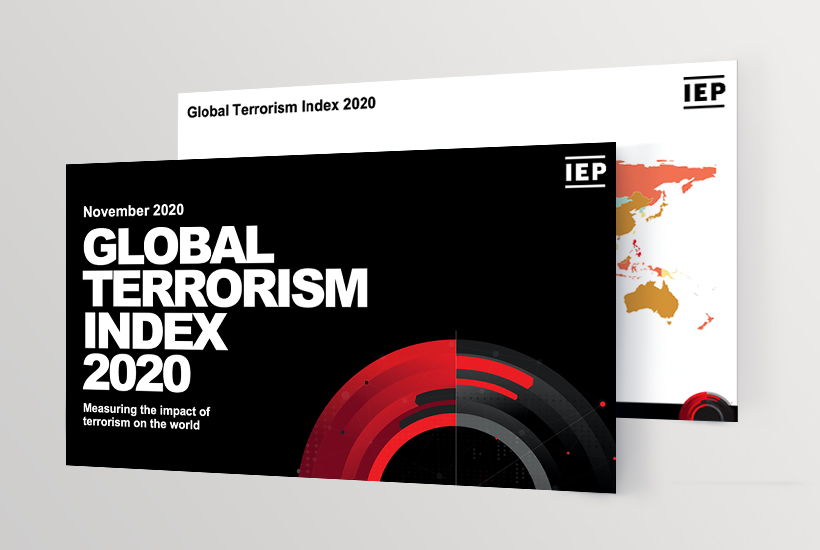
Source: https://www.visionofhumanity.org/resources/
A few statistics:
Deaths from Terrorism fall by 15% for fifth consecutive year to 13,800
The Islamic State of Iraq and the Levant (ISIL) core diminishes – first year where they caused less than 1,000 deaths since their inception
Far-right terrorism increases 250% in last five years- from low base
Deaths fall in the 4 countries with most deaths
ISIL centre of gravity shifts to sub-Saharan Africa – 7 of 10 largest increases in SSA
ISIL affiliates launch attacks in 27 countries
Impacts
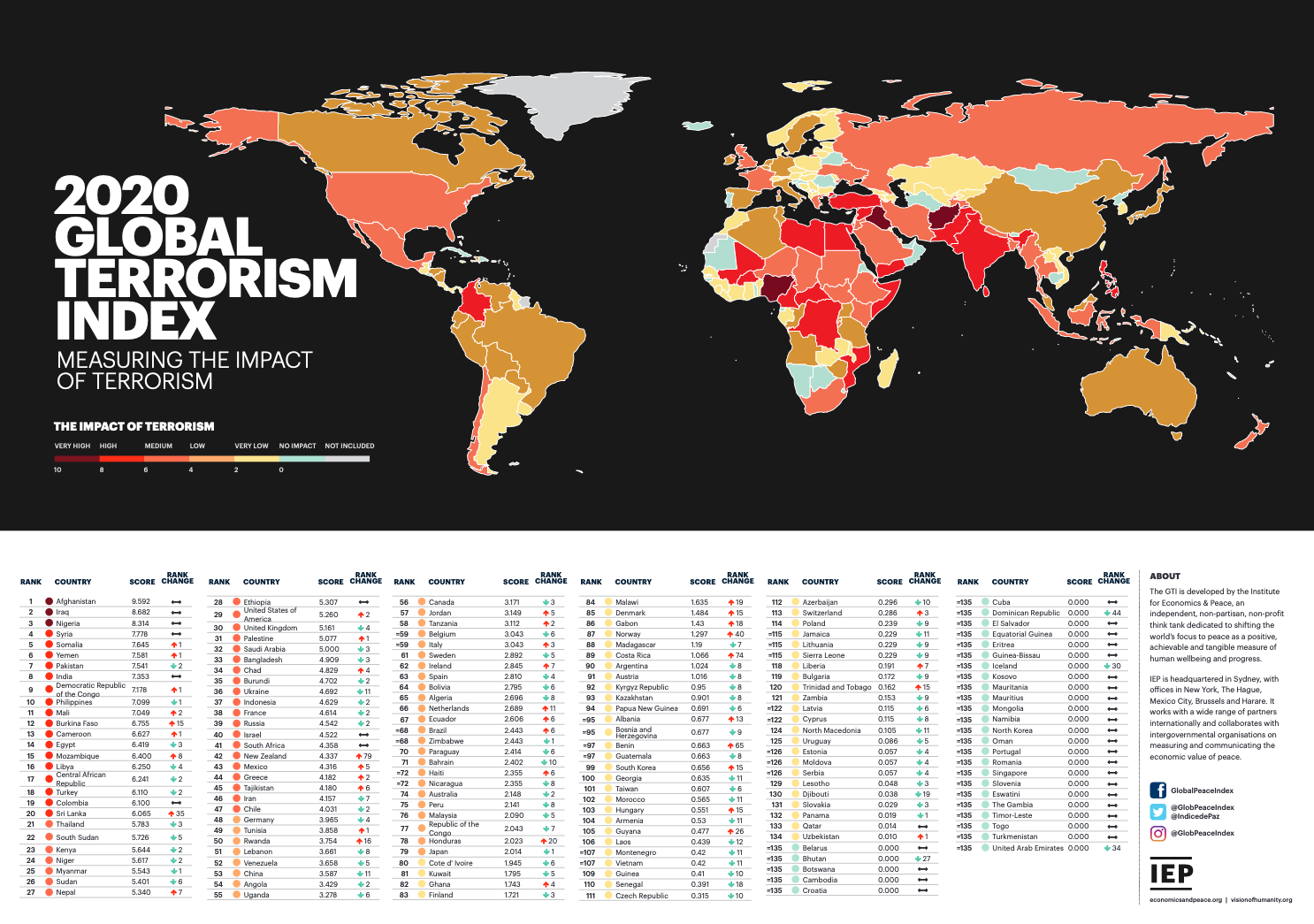
Costs
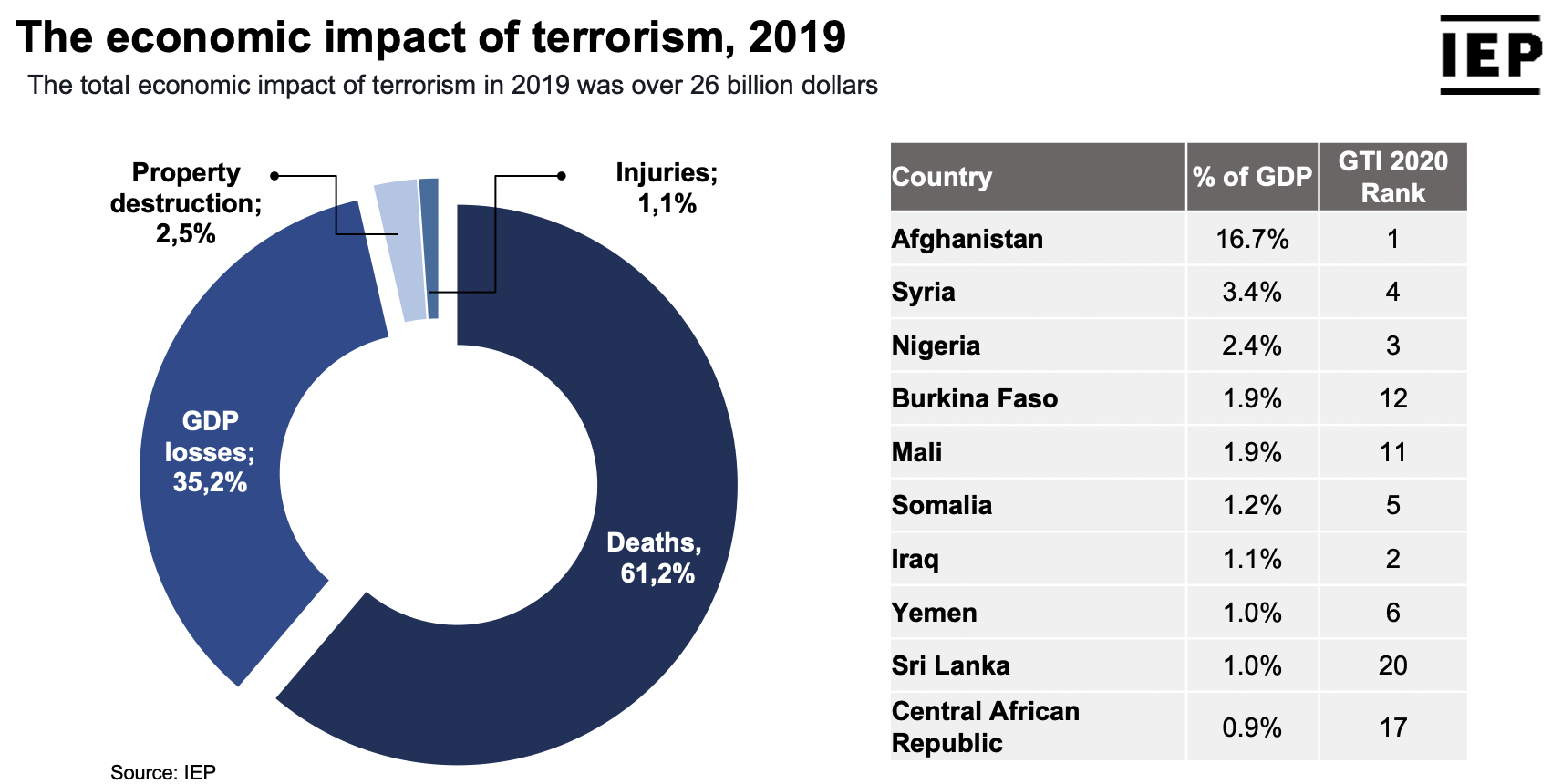
Evolution
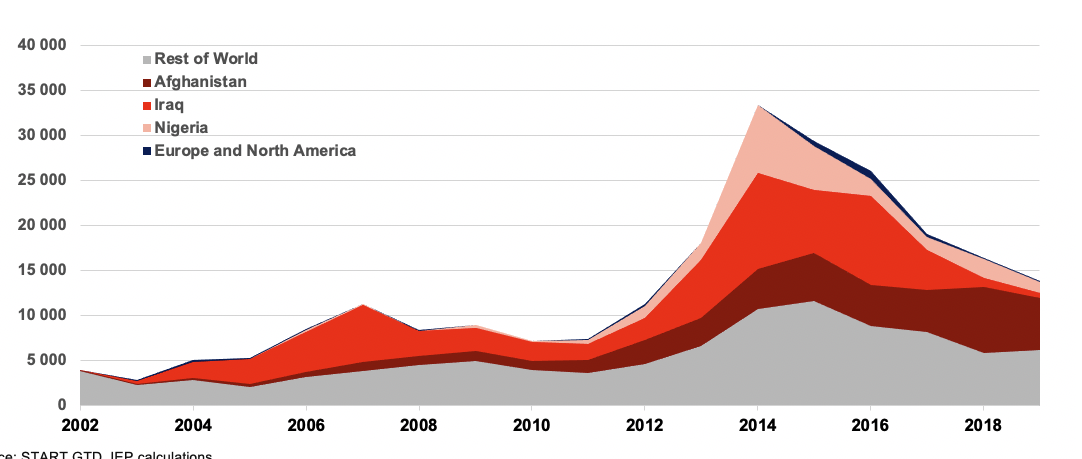
Global Terrorism Index
Rise of international terrorism and organized groups such as ISIS and Al-Qaeda…
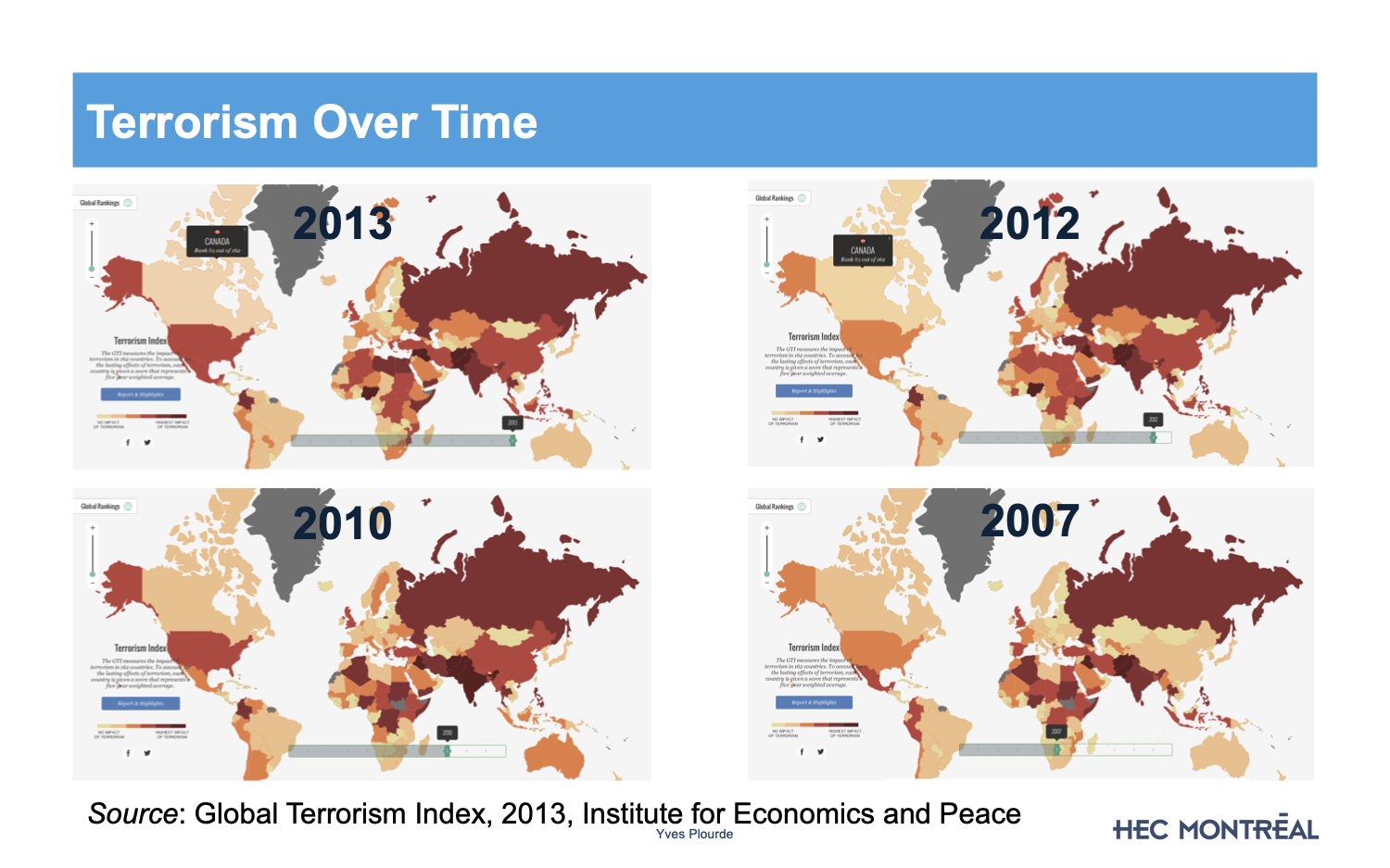
Deaths From Terrorism
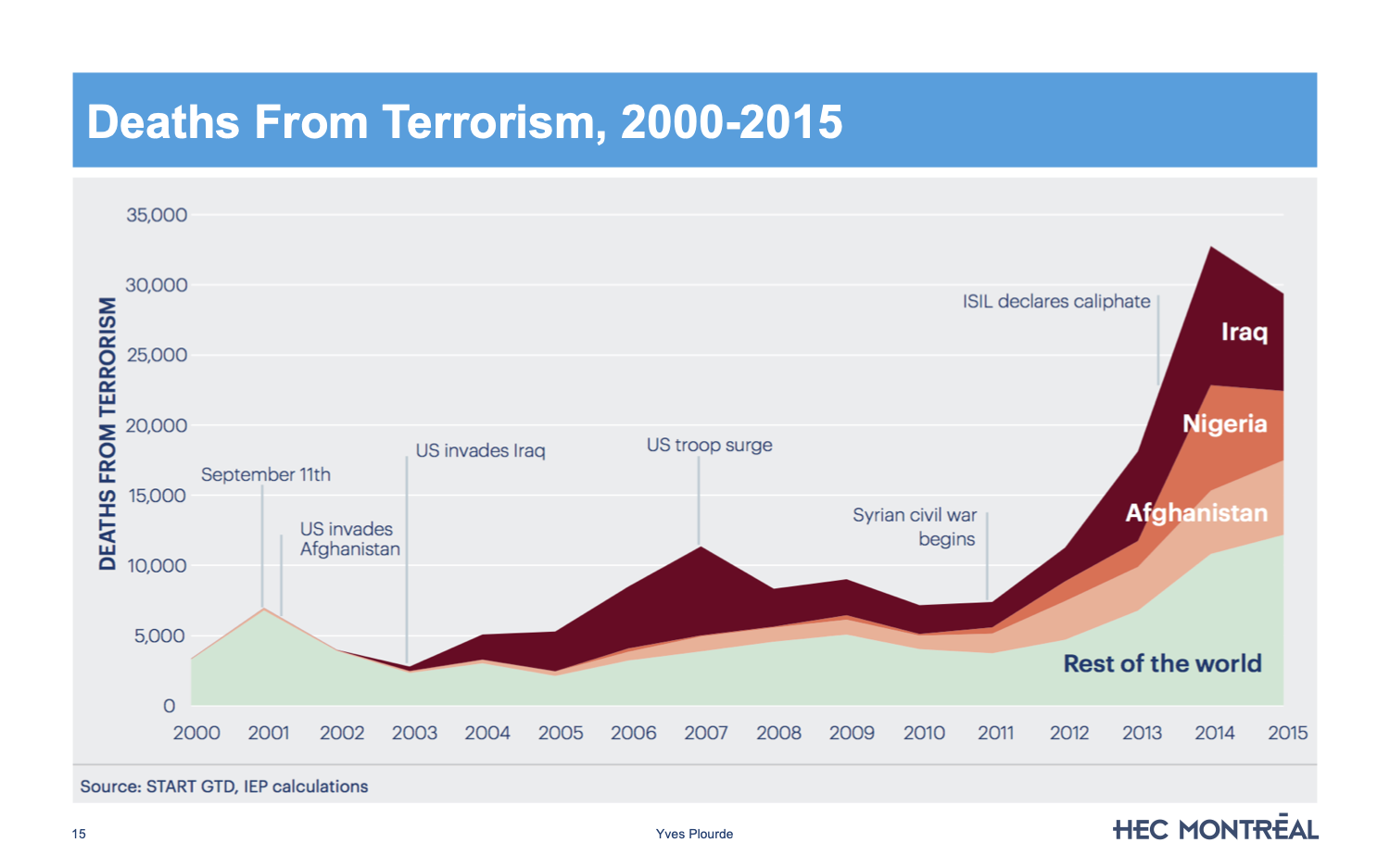
Countries with the Most Deaths

Numbers of Attacks

Attacks and Deaths per Region
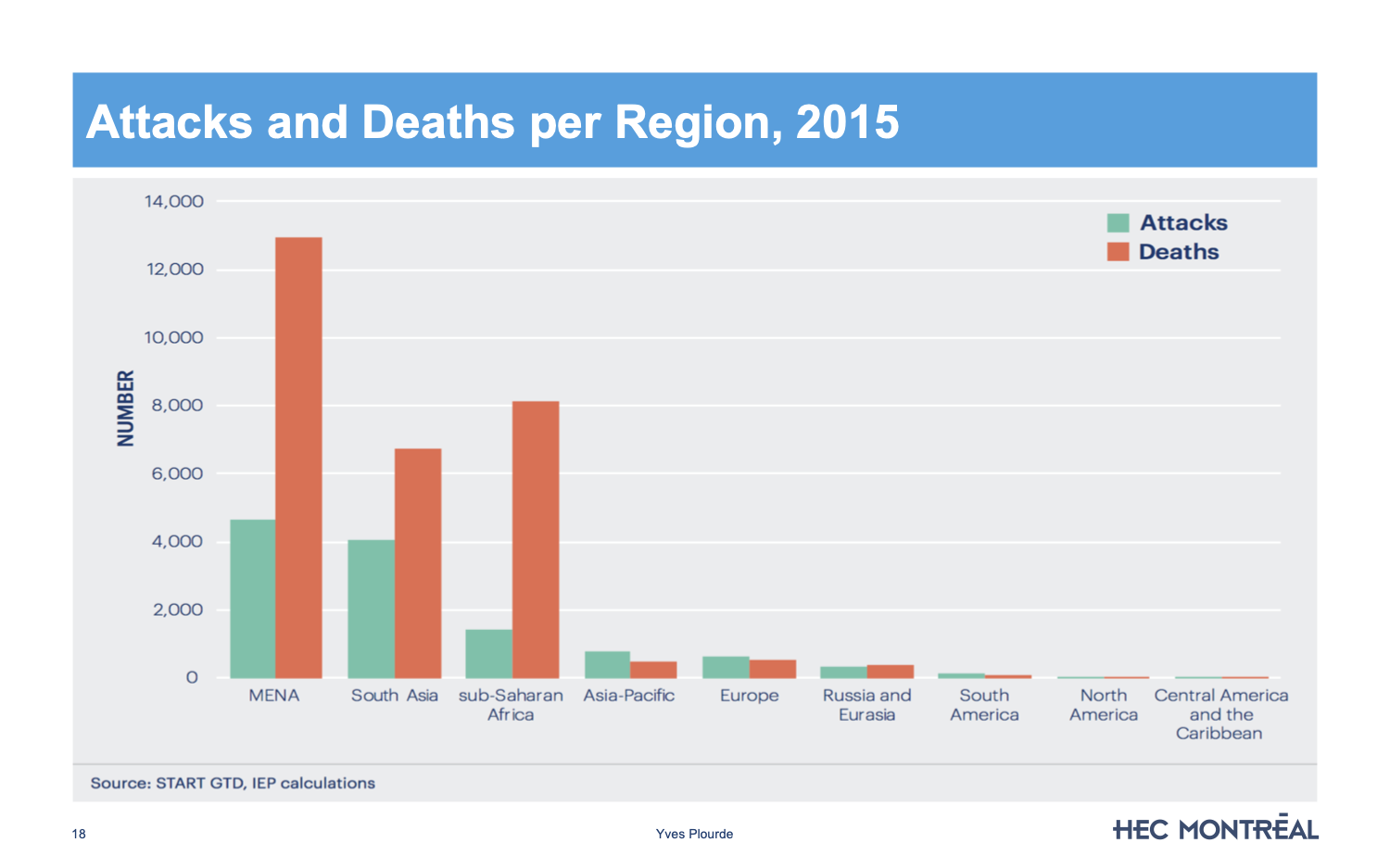
Deaths by Category of Actor
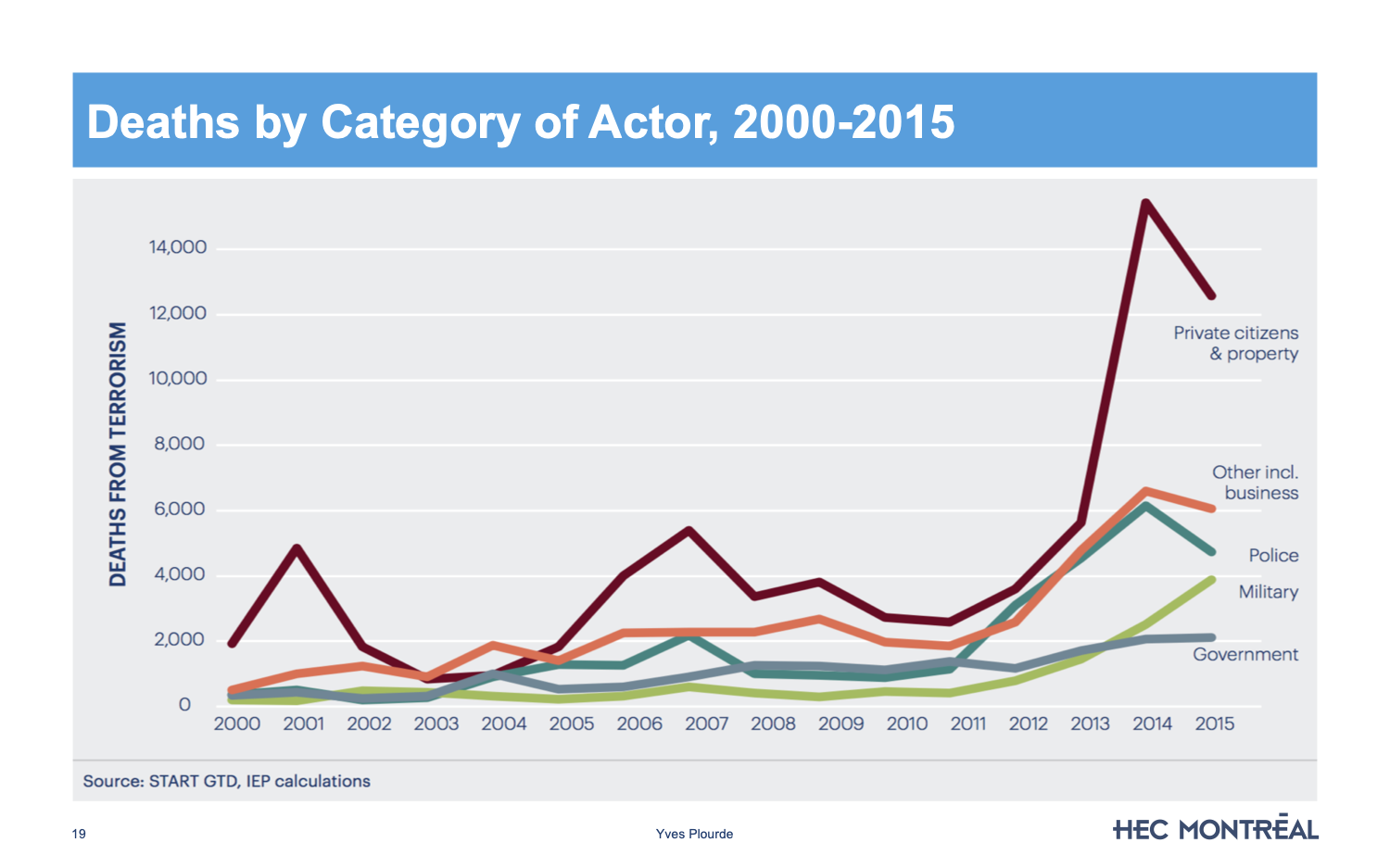
Number of Countries with Deaths
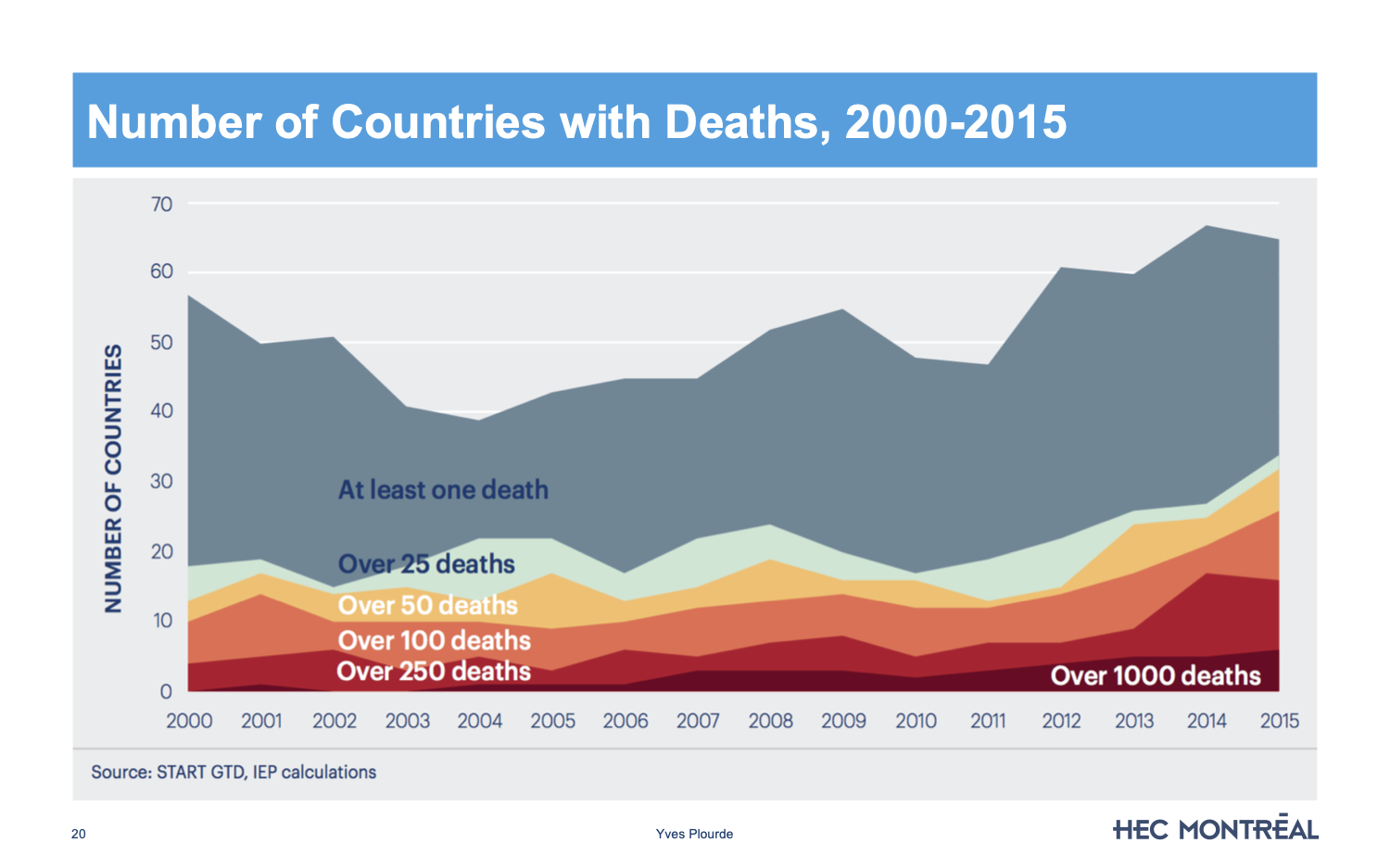
Deaths per Year
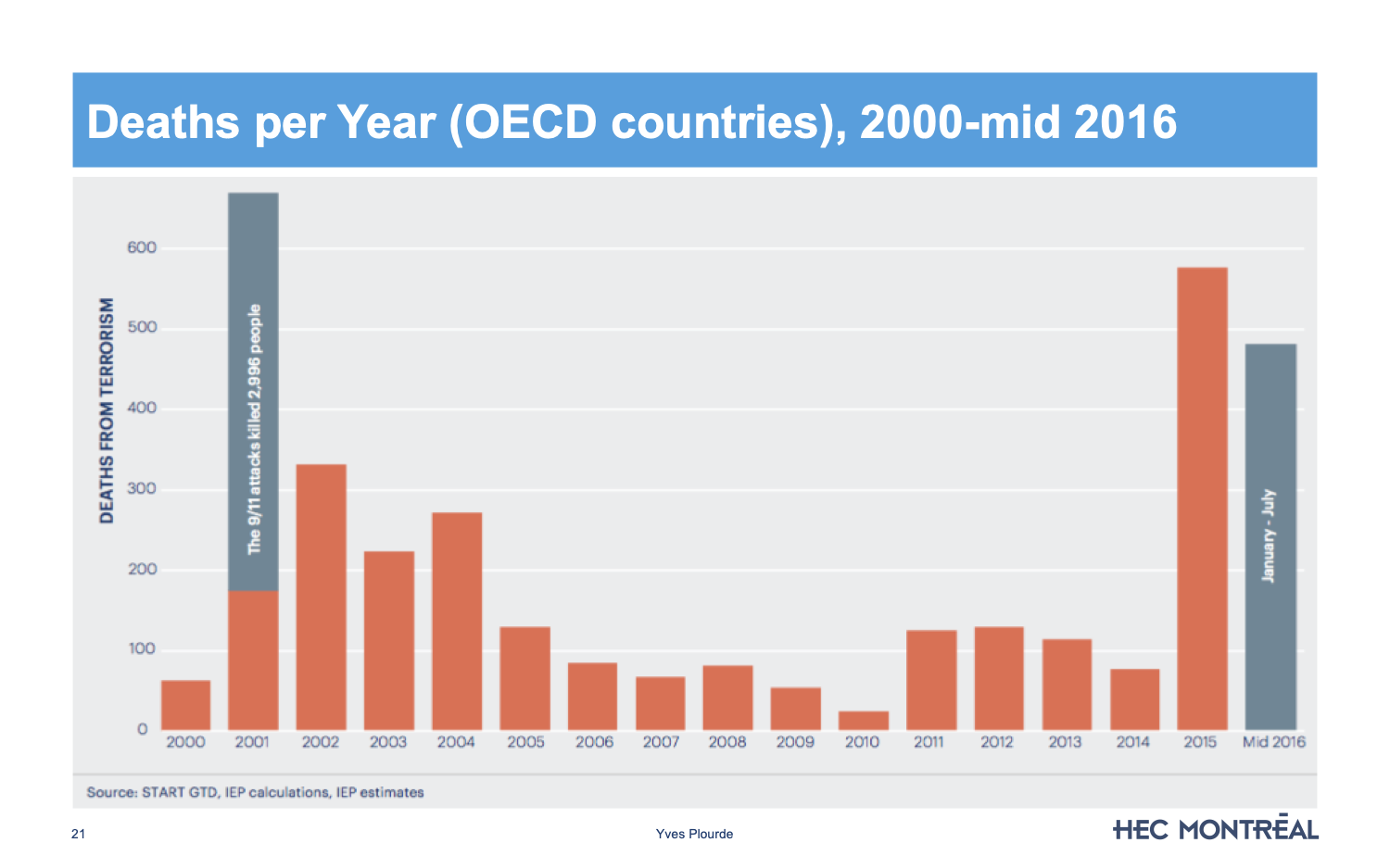
Effects of Terrorism
- Negative correlation between terrorism and FDI inflows for manufacturing, trade and repair, and construction sector
Corruption and Terrorism: Not the Only Issues
- Rise of tensions between countries…

13.2 War and its Consequences
War and Localization Choices
Effect of violence on FDIs depends on the type of violence, the characteristics of the industry, and the level of internationalization of the firm
Negative correlation with investments except for natural resources
For other sectors: firms that are «less » international are more sensitive to armed conflicts
Other types of violence (terrorism, killings) don’t have an impact on localization choices
War and MNCs’ Responses
A typical firm’s response is to exit
The more experience in conflict zones, the more likely a firm will delay departure
Valuable resources can become source of vulnerabilities that prompt early withdrawal
War and its Consequences: The Refugee Crisis
The Refugee Crisis in Context
Displacement in the 21st century (2000-2014)
Major refugee-hosting countries (2019)
Major refugee-sourcing countries (2019)
References
- Awan, I. (2017). Cyber-Extremism: ISIS and the Power of Social Media. Social Science & Humanities Open, 2(3), 1-12.
- Berger, J. M. (2017). Extremist Construction of Identity: How Escalating Demands for Leg
itimacy Shape and Define In-Group and Out-Group Dynamics. VOX-Pol Network of Excellence Working Papers. - Berger, J. M., & Morgan, J. (2015). The ISIS Twitter Census: Defining and Describing the Population of ISIS Supporters on Twitter. Brookings Institution. - Berman, E., Shapiro, J. N., & Felter, J. H. (2011). Can Hearts and Minds Be Bought? The Economics of Counterinsurgency in Iraq. Journal of Political Economy, 119(4), 766-819. - Botha, A. (2014). Radicalisation to Terrorism in Kenya and Uganda: A Political Socialization Perspective. Perspectives on Terrorism, 8(6), 1-18. - Clarke, C. P. (2018). After the Caliphate: The Islamic State and the Future Terrorist Diaspora. Foreign Affairs. - Passas, N. (2003). Informal Value Transfer Systems, Terrorism and Money Laundering: A Report to the National Institute of Justice. US Department of Justice. - Raleigh, C., Linke, A., Hegre, H., & Karlsen, J. (2010). Introducing ACLED: An Armed Conflict Location and Event Dataset. Journal of Peace Research, 47(5), 651-660. - Tollefsen, A. F., & Buhaug, H. (2015). Insurgency and Inaccessibility. International Studies Review, 17(1), 6-25.
12.3 Social Media Scraping: Tracking Recruitment, Propaganda, and Radicalization
The rise of social media has revolutionized how terrorist organizations communicate, recruit, and spread propaganda. Platforms such as Twitter, Facebook, and Telegram have become essential tools for terrorist groups to broadcast their messages, recruit new members, and coordinate activities. Social media scraping and text mining allow researchers to track these activities in real time, providing insights into the messaging strategies of terrorist groups and the effectiveness of counter-narratives.
Social media platforms have been particularly instrumental in radicalization efforts, with groups like ISIS and Al-Qaeda creating sophisticated online propaganda campaigns targeting vulnerable individuals in both the West and the Middle East. Natural language processing (NLP) and sentiment analysis tools are used to analyze the content of these messages, identifying key themes, emotional appeals, and recruitment strategies (Awan, 2017). By understanding the linguistic and emotional drivers of radicalization, analysts can develop more effective counter-radicalization campaigns that challenge the narratives propagated by terrorist organizations.
Hashtag analysis and topic modeling are also used to track how terrorist propaganda spreads across social networks. For instance, the hashtag #IslamicState was frequently used by ISIS sympathizers to promote the group’s propaganda on Twitter, allowing the group to reach a global audience. By tracking the usage of specific hashtags and identifying the accounts most responsible for spreading extremist content, researchers can pinpoint the epicenters of online radicalization efforts and target them for removal or counter-messaging.
In addition to monitoring the spread of propaganda, social media scraping is essential for tracking real-time operational activity. During the 2015 Paris attacks, ISIS operatives used encrypted messaging apps like Telegram to communicate and coordinate the attacks. Scraping these platforms for keywords, locations, and communication patterns allows security agencies to monitor ongoing activities and disrupt plots before they are executed (Berger, 2017).